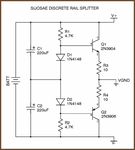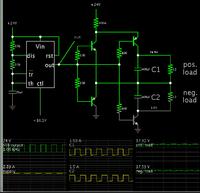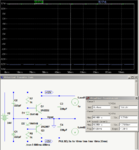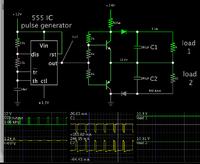designteam
Junior Member level 1
I am looking for a circuit design that will produce, from a 24VDC 2A regulated plug pack (SMPS wall wart), +/-10VDC rails with a virtual ground midway. Each rail needs to be capable of providing 1A continuous, or as close as practical.
I would prefer not to build a switching supply, use two separate linked supplies, or (for safety reasons) construct anything from scratch using 110/240VAC mains power. Hence I was considering the type of simple circuits illustrated on this webpage.
https://www.goldpt.com/virtual_ground_circuit.html
And also this transistor buffered option. But it seems a bit crude since the R3 and R4 would probably run hot.

The circuit I would like to power by this means (a sub-audio amplifier) has been successfully operated using two 12V 1A switch mode plug packs connected in parallel with isolating diodes. However, the +/- rails collapse simultaneously as soon as a resistive load is applied to the amp's output.
I assume the current is insufficient, but there may be another cause of which I am unaware. Unfortunately, I do not have access to a lab quality dual tracking supply with which to investigate further.
Can anyone please describe how to build a power supply as specified above, and ideally refer me to a schematic? I am willing to sacrifice some stability for simplicity.
PS: I can post the amp circuit here if it would be of use.
I would prefer not to build a switching supply, use two separate linked supplies, or (for safety reasons) construct anything from scratch using 110/240VAC mains power. Hence I was considering the type of simple circuits illustrated on this webpage.
https://www.goldpt.com/virtual_ground_circuit.html
And also this transistor buffered option. But it seems a bit crude since the R3 and R4 would probably run hot.

The circuit I would like to power by this means (a sub-audio amplifier) has been successfully operated using two 12V 1A switch mode plug packs connected in parallel with isolating diodes. However, the +/- rails collapse simultaneously as soon as a resistive load is applied to the amp's output.
I assume the current is insufficient, but there may be another cause of which I am unaware. Unfortunately, I do not have access to a lab quality dual tracking supply with which to investigate further.
Can anyone please describe how to build a power supply as specified above, and ideally refer me to a schematic? I am willing to sacrifice some stability for simplicity.
PS: I can post the amp circuit here if it would be of use.



